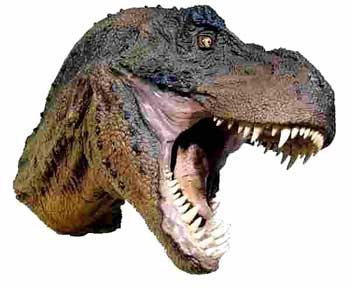The Tyrannosaurus rex (T.rex) not only possessed a remarkably keen sense of smell and hearing but also exhibited behaviors of using its vision to locate prey, similar to modern-day birds of prey.
The Tyrannosaurus rex was discovered and named 100 years ago.
Since then, this dinosaur has captivated the scientific community even further due to its extraordinary size—it could reach up to 12 meters tall and weigh 7 tons—with a skeletal structure featuring reduced forelimbs and enormous teeth.
With these characteristics, some researchers suggest that the creature was primarily a scavenger, akin to modern vultures.
 |
|
Tyrannosaurus rex (Illustration from an overseas website) |
Reconstructing Dinosaurs from Fossils
This hypothesis is further supported by CT scans of a T.rex specimen named Sue, which revealed extremely large olfactory bulbs that would have allowed the animal to smell carrion in its vicinity.
Francois Therrien and his research team from the Royal Tyrrell Museum of Palaeontology in Drumheller, Alberta, Canada, discovered a cavity at the front of the T.rex skull similar to that found in its distant relatives today, such as birds and crocodiles. This cavity likely limited the growth of the olfactory bulbs, which “might have been about the size of a plum.”
The T.rex had a very sensitive nose. The relative size of the olfactory bulbs compared to the two hemispheres of the brain was still larger than that of seven other dinosaur species, some of which had evolved similarly.
Lawrence Witmer and Ryan Ridgely from the Department of Biomedical Sciences at Ohio University in Athens, USA, also utilized CT scans to study the inner ear. The relative length of the cochlear spiral tube compared to the skull indicates that T.rex had better hearing than other carnivorous dinosaurs.
Wide Binocular Vision
The structure of the inner ear can provide insights into the posture and balance of this extinct creature.
 |
|
T-Rex as illustrated by foreign experts |
The length of the semicircular canals, which help the brain determine the body’s orientation and movement in the T.rex, is remarkably developed. According to Witmer, the long canals in the cochlea allowed the dinosaur to maintain the position of its head and both eyes for accurate prey location.
In modern animals, the orientation of the lateral canal to the skull is linked to the head’s position when raised. The T.rex maintained a head position tilted down by 5 to 10 degrees. For long-snouted animals, a slight downward tilt helps them see prey more clearly.
American researcher Kent Stevens from the University of Oregon also reached similar conclusions about the vision of the T.rex, placing it among the top tier of predators.
He assessed the vision of the T.rex and six other carnivorous dinosaurs through experiments recreating the sculpture of the animal’s head. By positioning a stimulus in front of the head sculpture and directing a laser beam toward the dinosaur’s pupil, he mapped out its visual field.
The T.rex has an exceptionally wide binocular vision.
When it tilted its head down by 10 degrees, it optimized its visual field with a perception of depth similar to that of birds. According to Kent Stevens, with its acute sensitivity to depth, sound, and smell, the T.rex deserves to be considered a prime example of a superlative predator.
James Hopson from the University of Chicago notes that although the hypothesis of the T.rex as a scavenger remains widely accepted, it is still plausible that the T.rex also hunted live prey.


















































